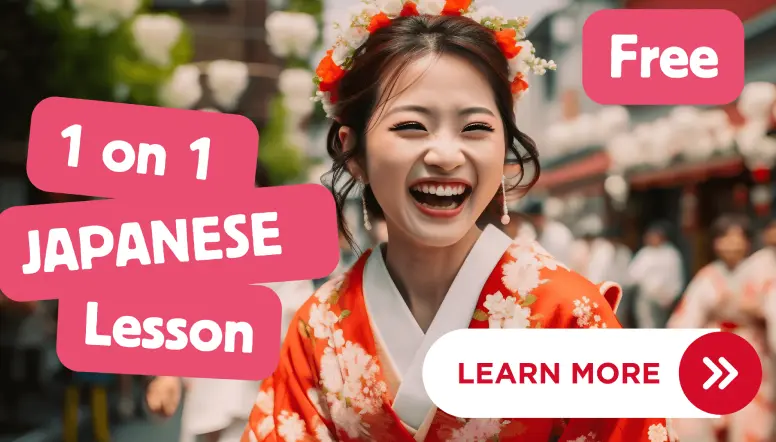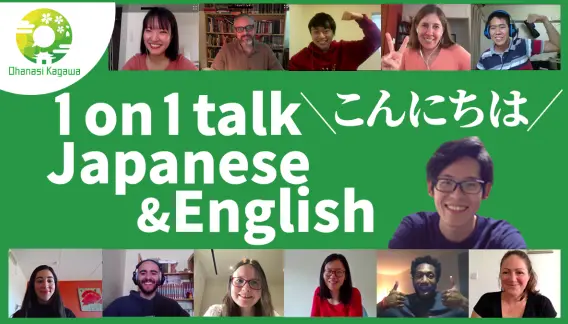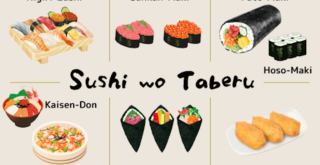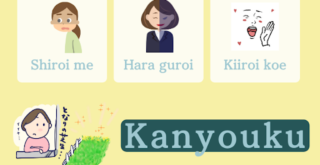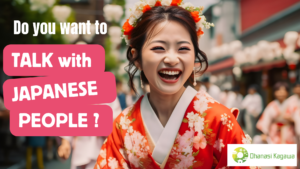
Learn Japanese
Japanese Culture
Ohanasi Kagawa
Ohanasi Japanese Language School
2023.09.15
【Nihongo-Level ★★☆☆】How to use these similar meaning verbs correctly
Japanese Learners might make a mistake? Hi I'm Satomi. I have taught Japanese to foreigners for more than 4 years. I realized some of them might make a mistake even if they are intermediate students.Today, I want to explain how to distinguish them. Quiz Choose the appropriate verb. aゆでる bたく cむす dにる 1.こめを ( )。2.パスタを( )。3.肉まんを( )。4.カレーを( )。 *I'll show you these answers at last! Introducing the way of using them ごはんを たく たく(炊く・TAKU) :To add water, soup stock, seasonings, etc. to food and heat to moisten it. After cooking is complete, no water is left behind and the food absorbs the moisture and becomes fluffy. ※Caution "たく" rarely used in eastern Japan except for "cooking rice". On the other hand, in Kansai, the word "たく" is used to describe "boiling in water that has been completely filled with water". たまごを ゆでる ゆでる(茹でる・YUDERU) :To heat the food through to the center. Not to flavor with any seasonings except for salt. (Sometimes salt is added to boiling water.) ぎょうざを むす むす(蒸す・MUSU) :Indirect heating of food by placing it in steam. さといもを にる にる(煮る・NIRU) :To put ingredients in water, broth, or other liquid to heat and season. ※Caution The difference from "ゆでる" is that not only the cooked food but also the broth is served together. Example sentence 米を たく。/ 米(こめ)=rice ごはんを たく。/ごはん =rice パスタを ゆでる。/パスタ=pasta 野菜を ゆでる。/野菜(やさい)=vegetable 肉まんを むす。/肉まん(にくまん)=manju (steamed bun) with meat filling プリンを むす。/プリン=pudding カレーを にる。/カレー=curry 魚を にる。/魚(さかな)=fish スープを にる。/スープ=soup Answer of Quiz 1.こめを (たく)。2.パスタを(ゆでる)。3.肉まんを(むす)。4.カレーを(にる)。 Check the Post @Instagram Wouldn’t it be a great way to practice if you could try using the grammar we learned today in a real conversation with Japanese friends? How to put yourself in an environment where Japanese is used a lot. 1.You can ask your questions face to face outside of lessons!2.You can discuss with English learners through writing whenever you want!3.You can find language partners safely! https://youtu.be/2MT9VCaSmCw?si=0sTxy4-qZ25UaDNe Do you want to put yourself in an environment where Japanese is used a lot? Please check our website if you would like to experience a new way to learn Japanese.
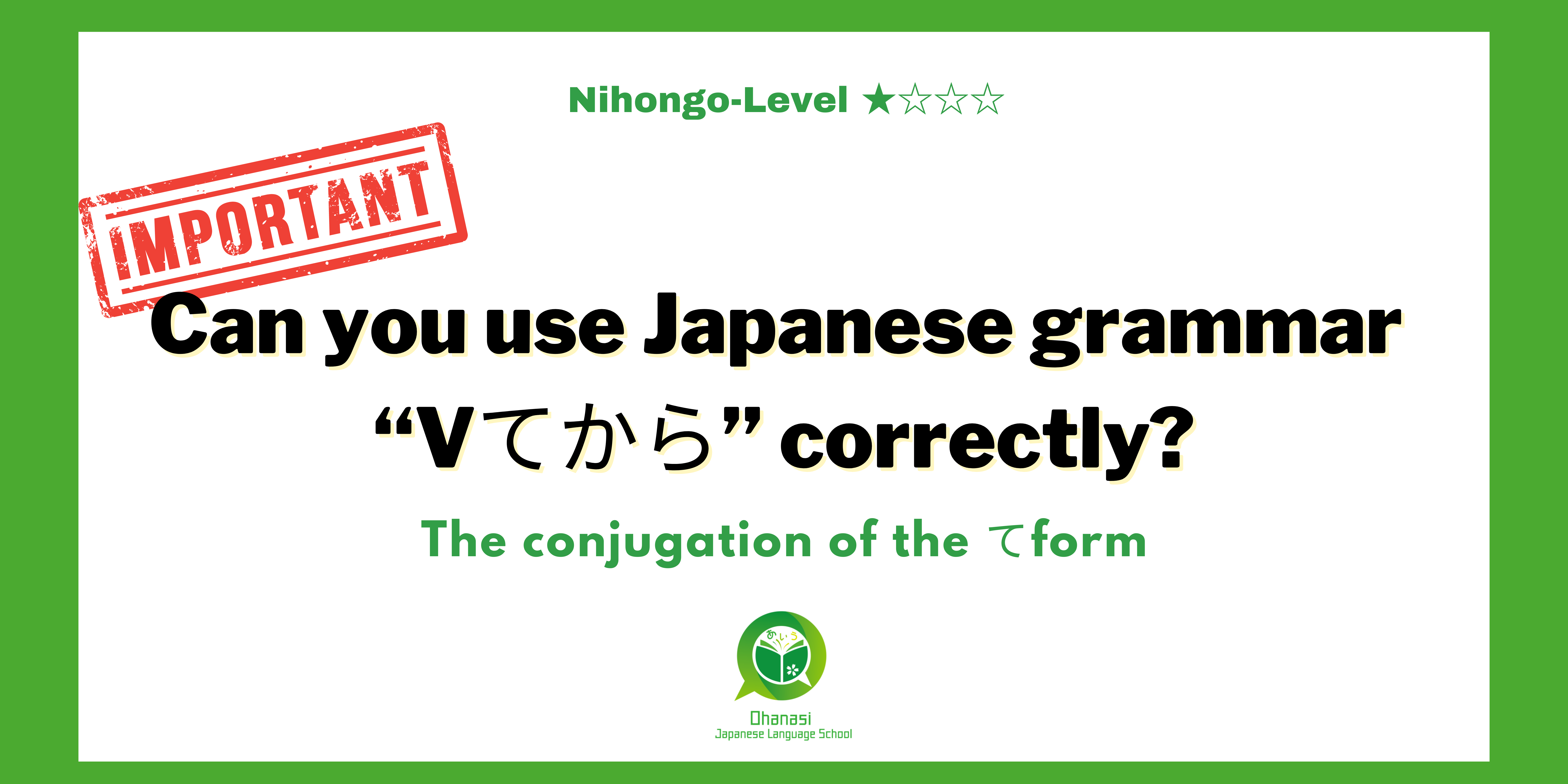
Learn Japanese
Japanese Culture
Ohanasi Kagawa
Ohanasi Japanese Language School
2023.08.25
【Nihongo-Level ★☆☆☆】Can you use Japanese grammar “Vてから” correctly?
"てform can be difficult to use because of its complex conjugated forms.Can you answer all of the following questions?" Review てform of a Verb + から (~て + から)Vてから means “after doing (verb)…” Quiz1【The conjugation of the てform】 Answer the てform of these verbs. ①彼に ( )から、 会社に行きます。 KARENI ( )KARA KAISHANI IKIMASU. ②毎朝、牛乳を( )から、運動をします。MAIASA GYU-NYU-WO ( ) KARA UNDOUWO SHIMASU. ③母は、ご飯を( )から、歯をみがきます。HAHAWA GOHANWO ( )KARA HAWO MIGAKIMASU. ④兄は、運動( )から、シャワーを浴びます。ANIWA UNDOU( )KARA SHAWA-WO ABIMASU. ⑤家に友達が( )から、料理をはじめます。IENI TOMODACHIGA( )KARA RYO-RIWO HAJIMEMASU. Answers and Review for Quiz 1 ①あってから 彼に あってから、 会社に行きます。 KARENI ATTEKARA KAISHANI IKIMASU.ーI will go to the office after meeting him.②のんでから 毎朝、牛乳をのんでから、運動をします。 MAIASA GYU-NYU-WO NONDEKARA UNDOUWO SHIMASU.ーI exercise every morning after drinking a cup of milk.③たべてから 母は、ご飯をたべてから、歯をみがきます。 HAHAWA GOHANWO TABETEKARA HAWOMIGAKIMASU.ーMy mom brushes her teeth after having breakfast.④してから 兄は、運動してから、シャワーを浴びます。 ANIHA UNDOUSHITEKARA SHAWA-WO ABIMASU.ーMy brother takes a shower after exercising.⑤きてから 家に友達がきてから、料理をはじめます。 IENI TOMODACHIGAKITEKARA RYO-RIWO HAJIMEMASU.ーI’ll start cooking after my friends come to my house. Were you able to answer all the questions? Even if you didn't answer everything, please don't feel nervous!Let's practice together! Let’s practice how to conjugate the てform ①あう あう is a verb in group 1.Also, the last Hiragana of あう is “う”.That means that the てform of あう is あって. ②のむ のむ is a verb in group1.Also, the last Hiragana of のむ is “む”.That means that the てform of のむ is のんで. ③たべる たべる is a verb in group 2.Because of that, the てform of たべる is たべて. ④運動する 運動する(する verbs) is a verb in group 3.Since 運動する is a verb in group 3, the てform will be 運動して. ⑤くる くる is a verb in the group 3.That’s why てform of くる is きて. Quiz2【Practice the てform more】 Are you ready to practice てform some more?Please choose the correct conjugation. ①父と( )から、先生に電話をします。1はなせて 2はなんで 3はなすって 4はなして ②家に( )から、手を洗ってね。1ついて 2ついって 3つきて 4つくって ③映画館に( )から、ポップコーンとコーラを買おうよ!1いくて 2いって 3いいて 4いんで ④日本では くつを ( )から、家に入りますよ。1ぬんで 2ぬきて 3ぬいで 4ぬって ⑤髪を( )から、モテるようになった。嬉しい!1きて 2きって 3きいて 4きて Answers and Review for Quiz 2 Let’s check the correct answers together. I’ll also explain how to conjugate these verbs correctly! ①4父と はなしてから、先生に電話をします。CHICHITO HANASHITEKARA SENSEINI DENWAWO SHIMASU.ーI’ll call my teacher after talking to my father. はなす is a verb in group 1.Also, the last Hiragana of はなす is “す”.That means that the てform of はなす is はなして. ②1家に ついてから、手を洗ってね。IENI TSUITEKARA TEWO ARATTENE.ーWash your hands after arriving home. つく is a verb in group 1.Also, the last Hiragana of つく is “く”.That means that the てform of つく is ついて. ③2映画館に いってから、ポップコーンとコーラを買おうよ!EIGAKAN NI ITTEKARA POPPUKO-N TO KO-RA WO KAOUYO.ーLet’s buy popcorn and soda when we get to the theater. ※いく is an irregular verb in group 1. The last Hiragana of いく is “く” but it doesn’t conjugate into “いいて” like “つく”.Please be careful with this verb!! The てform of いく is いって. ④3日本では くつを ぬいでから、家に入りますよ。NIHONDEHA KUTSUWO NUIDEKARA IENI HAIRIMASUYO.ーIn Japan, it’s common to enter a house only after taking off your shoes. ぬぐ is a verb in group 1.Since ぬぐ is a verb in group 1 and the last hiragana is ぐ, we know that the てform of ぬぐ is ぬいで. ⑤2髪を きってから、モテるようになった。嬉しい!KAMIWO KITTEKARA MOTERUYOUNI NATTA. URESHIIーI started to feel more attractive after cutting my hair. ※Make sure to note that there are multiple words spelled ‘きる’ in Japanese.きる(切る:to cut) is a verb in group 1.※It is not in group 2. Meanwhile, きる(着る : to wear)is in group 2.That’s why てform of 切る(to cut) is きって(切って), and theてform of 着る(to wear) is きて(着て).Make sure to double check which group a verb belongs in when conjugating! A quick wrap-up Did you understand the conjugations of the てform?If you can use it correctly, you might be able to talk with Japanese people like a native speaker!Please don’t forget these rules and review them whenever you forget them. Check it whenever you want to review the conjugation of てform. Check the Reels @Instagram Wouldn’t it be a great way to practice if you could try using the grammar we learned today in a real conversation with Japanese friends? Ohanasi Japanese Language School has 3 differences compared to other schools. 1.You can ask your questions face to face outside of lessons!2.You can discuss with English learners through writing whenever you want!3.You can find language partners safely! https://youtu.be/2MT9VCaSmCw?si=0sTxy4-qZ25UaDNe Do you want to put yourself in an environment where Japanese is used a lot? Please check our website if you would like to experience a new way to learn Japanese.

Japanese Culture
Ohanasi Kagawa
Ohanasi Japanese Language School
2023.08.05
Find your perfect online Japanese tutor: Start a new way to learn!
Do you want to meet your ideal online Japanese tutor? Are you looking for a new way to learn Japanese? With online Japanese tutoring, you can learn at your own pace without being limited by time or location. With Ohanasi Kagawa, you are sure to find the right tutor for yourself. This article explains why we at Ohanasi Kagawa recommend studying Japanese and how to get the most out of your learning experience. If you read to the end, you will know how to find the right online Japanese tutor for yourself! We are here to help you learn Japanese effectively and communicate with confidence. Start a new learning experience and explore the fascinating world of the Japanese language! Why should you choose our Online Japanese Tutoring? First, let us explain why you should choose our online Japanese tutoring: Ohanasi Kagawa's online Japanese events offer flexibility, accessibility, and a unique language exchange experience. https://youtu.be/oZ_I3A-xBYo?si=gnQJi5CtqrcnEWd9 https://ohanasikagawa.com/online-event/ Participants are not restricted by time or location, and they can work at their own pace! At the events, participants can improve their Japanese conversational skills by communicating with Japanese speakers in real time through the online platform. At our unique language exchange events, participants will be able to deepen their cultural understanding and enjoy cross-cultural exchange through dialogue with Japanese speakers. Our events are a great opportunity for learners to learn Japanese effectively while having fun, while providing flexibility and accessibility. Let's take a closer look below! Flexibility and Accessibility Ohana Kagawa's online language exchange events are flexible and accessible. Because they are online, you can participate from anywhere in the world. You can choose from six event dates and times per month on weekends to fit your schedule. The events themselves are free, and since there is no need to travel, you save time and transportation costs. With the unique features of online learning, this is the perfect way for those who want to learn at their own pace despite their busy schedules; take advantage of Ohanashi Kagawa's online language exchange events and learn at your own pace, free from the constraints of location and time. The key is to enjoy an experience that offers flexibility and convenience and leads to continued learning. Unique Language Exchange Events Ohanasi Kagawa's unique language exchange events are a great opportunity to improve your Japanese language skills through real conversations. By interacting with Japanese speakers and other learners, you can hone your natural ability to express yourself. Another advantage of learning from actual Japanese speakers is that you can learn pronunciation and cultural nuances that can be easily conveyed. Furthermore, you can make friends through interaction with international participants. In this way, Ohanasi Kagawa events provide an exciting and enriching language exchange experience for learners. Participants can enrich their Japanese language learning experience by practicing their skills and connecting with people from different cultures and backgrounds. We invite you to join Ohanasi Kagawa's unique language exchange events for hands-on learning and international networking! No Expertise Required: How We Teach Ohanasi Kagawa believes that participants do not need to be an expert in teaching Japanese to teach Japanese. The emphasis is on building a teaching relationship between Japanese speakers who learn English and English speakers who learn Japanese by interacting with each other. With continuous real-time feedback from each other, learners can continue to grow through self-assessment, and we believe that Ohanasi Kagawa's approach is an effective way to help learners learn Japanese with confidence. Anyone can participate in the program, even if they are not a specialist in Japanese language education, so it is recommended for those who feel that attending a Japanese language school is too much of a hurdle. Join us and try the experience of teaching each other the language. Make the most of your learning with Japanese Tutoring Near You! Ohanasi Kagawa aims to maximize your learning experience with Japanese tutoring near you. We are making international exchange more accessible, creating a place where people from Japan and around the world can connect more easily and safely. The appeal of this program is that Japanese speakers who are interested in international exchange are highly motivated to learn the language, as they are motivated to learn English. All participants are eager to learn the language, so even those who feel that they lack confidence in their own Japanese can feel comfortable participating. Accessible Japanese Culture Through Online Japanese Tutoring, learners have the opportunity to experience Japanese culture through Ohanasi Kagawa's Language Exchange, where they can ask Japanese speakers directly about Japanese culture. You can learn about Japanese etiquette and social customs, and deepen your understanding of greetings and behaviors that improve the atmosphere. By acquiring knowledge about Japanese customs, traditions, and food culture in the course of Japanese language tutoring, you will deepen your understanding of Japanese culture. Through the flexibility of the online environment and real-time communication, you can enjoy both language learning and Japanese culture at the same time, and through Ohanasi Kagawa's program, you can broaden your international horizons while learning Japanese and experiencing Japanese culture! Ohanasi Kagawa's language exchange events are held six times a month on weekends. Participants can attend events at their convenience, so please check the schedule. Applications are available through the Ohanasi Kagawa website. You can sign up first and then apply for the event of your choice. Ohanasi Kagawa's language exchange events are a great way to experience online Japanese tutoring. We tailor the learning experience to fit your lifestyle. We place the highest priority on participants' ease of speaking, interaction, and safety, so you can focus on your language exchange time with peace of mind. Wherever you are, you can start a new journey of Japanese language learning with our online Japanese tutoring service. 【For Japanese Learners】 Limited to 10 people Free Consultation & Japanese Lesson ↑Click to the website! We are organizing a free Japanese language consultation & free Japanese lesson for Japanese learners. “Even though I’m studying Japanese, I can’t speak it.” “I don’t know how to study Japanese.” “I’m worried that I can’t see any progress.” Our Japanese Language Learning Counselors would be happy to listen to the concerns of such beginner- or intermediate-level Japanese language learners and advise them on how to learn Japanese and solutions that suit their needs. ※Due to the limited time of our Japanese Language Counselors, we limit the number of participants to 10. We at Ohanasi Kagawa are currently hosting an online Japanese-English language exchange event on weekends.However, we have noticed that there are many people who want to participate but are not confident enough in their Japanese to do so. We are holding this free Japanese language study consultation in the hope that we can help Japanese learners find hints to help them move forward.You can book through the calendar below, and we will send you a link for the free counseling by e-mail.If you’d like to take a Japanese lesson, you can take it for free during this time. Book a free counseling and trial lesson >>>
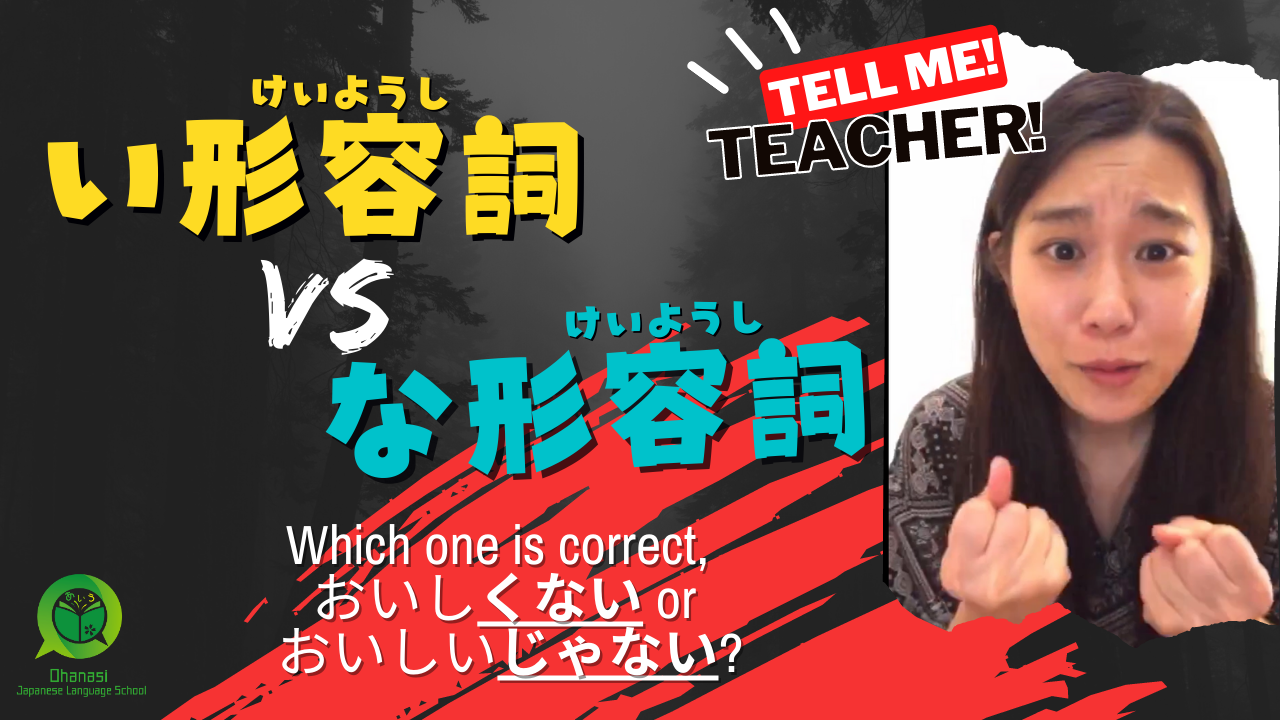
Learn Japanese
Japanese Culture
Ohanasi Kagawa
Ohanasi Japanese Language School
2023.08.04
【3mins Nihongo Quiz】Which is correct?The negative form of いadjective VS なadjective
What’s the difference between いadjective and なadjective? Hi!! I'm Satomi in Ohanasi Japanese Language School.Today, I'll teach you about adjectives in Japanese !! QUIZ TIME !! Choose the correct answers. 1.このカレーは、 ( a.おいしくない / b.おいしいじゃない )。 2.お姉ちゃんのスカートは、黒い。だから、 ( a.はでくない / b.はでじゃない )。 3.このコーヒー、にがい! ( a.あまくない / b.あまいじゃない )! 4.私の母は、声が小さいので、( a.うるさいじゃない / b.うるさくない )です。 5.私は、運動が ( a.好きじゃない / b.好きくない )です。つかれるからです。 6.このスマホは5年前に買いましたから、 ( a.あたらしいじゃない / b.あたらしくない )です。 Answer 1.このカレーは、 ( a.おいしくない )。 This curry is not good (tasty) . 2.お姉ちゃんのスカートは、黒い。だから、 ( b.はでじゃない )。 My sister's skirt is black. So it's not flashy. 3.このコーヒー、にがい! ( a.あまくない )! This coffee is so dark ! It's not sweet ! 4.私の母は、声が小さいので、( b.うるさくない )です。 My mom has a quiet voice, she is not noisy. 5.私は、運動が ( a.好きじゃない )です。つかれるからです。 I don't like exercise because I feel tired after it. 6.このスマホは5年前に買いましたから、 ( b.あたらしくない )です。 This smartphone is not new because I bought it 5 years ago. The rule of negative form in いadjective and なadjective 1.このカレーは、 ( a.おいしくない )。→おいしい is いadjective. The negative form is 「おいしい+くない=おいしくない」 2.お姉ちゃんのスカートは、黒い。だから、 ( b.はでじゃない )。→はでな is なadjective. The negative form is 「はでな+じゃない=はでじゃない」 3.このコーヒー、にがい! ( a.あまくない )!→あまい is いadjective. The negative form is 「あまい+くない=あまくない」 4.私の母は、声が小さいので、( b.うるさくない )です。→うるさい is いadjective. The negative form is 「うるさい+くない=うるさくない」 5.私は、運動が ( a.好きじゃない )です。つかれるからです。→好きな is なadjective. The negative form is 「好きな+じゃない=好きじゃない」 6.このスマホは5年前に買いましたから、 ( b.あたらしくない )です。→あたらしい is いadjective. The negative form is 「あたらしい+くない=あたらしくない」 Check the Reels @Instagram Thank you for reading the blog!Please check our event here👇You can practice conversation with Japanese friends for free. Also, you can join it every weekend. Join Ohanasi Kagawa

Learn Japanese
Japanese Culture
Ohanasi Kagawa
Ohanasi Japanese Language School
2023.07.19
【Nihongo-Level ★☆☆☆】Do you know how to count tuna in Japanese?
This is an useful knowledge when you learn Japanese !! Yana teacher will teach you ^^ Hi!! I'm Satomi in Ohanasi Japanese Language School.Today, I'll teach you how to count tuna in Japanese. QUIZ TIME !! Choose the correct answers. 1.A tuna swimming in the ocean is called ( ). 2.When you catch it, it's called ( ). 3.When you cut the tuna into pieces, it's called ( ). 4.The tuna that is further cut into pieces is called ( ). 5.Tuna sold in stores in called ( ). 6.The tuna that goes into your mouth is called ( ). a)hitokoro b)ippiki c)hitokire d)hitosaku e)ippon f)iccho Answer 1.A tuna swimming in the ocean is called ( ippiki/一匹 ). 2.When you catch it, it's called ( ippiki/一本 ). 3.When you cut the tuna into pieces, it's called ( iccho/一丁 ). 4.The tuna that is further cut into pieces is called ( hitokoro/一塊 ). 5.Tuna sold in stores in called ( hitosaku/一柵 ). 6.The tuna that goes into your mouth is called ( hitokire/一切 ). 1.b)ippiki 2.e)ippon 3.f)iccho 4.a)hitokoro 5.d)hitosaku 6.c)hitokire Check the Reels @Instagram Thank you for reading the blog!Please check our event from here👇You can practice conversation with Japanese friends for free. Also, you can join it every weekend. Join Ohanasi Kagawa

Learn Japanese
Japanese Culture
Ohanasi Kagawa
Ohanasi Japanese Language School
2023.07.13
【ADVICE to Japanese learners】Vol.2/ Do you lend your ears to Japanese friends?
Do you have some Japanese friends? If you do, I believe that today's topic is useful when you talk with them !! Hi!! I'm Satomi in Ohanasi Japanese Language School.Today, I'll teach you about 5 important points that Japanese people feel is important in the conversation. Read Vol.1*Click !!* The 5 important points of 【傾聴】 So, what should you be careful of when you communicate with Japanese people? I’ll share you 5 important things to keep in mind talking with them. 1.Gazing : In general, it’s better to gaze at friends every 3 seconds.You don’t need to stare at your friends for more than 5 seconds. (It might make your friends nervous.) 2.Smiling:In order to not make them feel uncomfortable, it’s good to smile when you listen to what they are saying. Even if there is a “silent time” in the conversation, it’s not a big deal. If there is, don’t feel rushed, and stay calm. 3.Nodding:Many Japanese people tend to nod during conversation, because it shows their interest in others. It’s better to nod while saying “なるほど”(I see.), “わたしもです”(Me too.), or similar expressions. 4.Talking to:For example, when you talk to them, calling their name with “~さん” is such an effective way to make good conversation in Japan.Also, it’s a good way to prioritize that they’re saying. 5.Praise:You don’t need to say exaggerated things to them, because many Japanese people are often modest if you praise them too much. Like... “Your clothes today are so nice! It really suits today's weather”. Choice of clothing can be an easy way to give praise. It won’t make them so nervous. When you communicate with Japanese people, it’s important to help them feel comfortable. A comfortable mood will help them feel relaxed when talking with you. I hope you can talk with Japanese friends with these 5 points. Let’s use it in real conversation !! You can’t improve communication skills without trying to practice, and that's true for whatever you want to learn. Of course, it’s hard to do well at first. Also, I think it’s important to try little by little. But, how can you get an opportunity to practice talking with Japanese people? You can join the free online event, Ohanasi Kagawa. This is an online platform where you can practice conversation with native Japanese people. It's a fun, educational way to spend the evening! You can join the event any number of times and talk with a lot of Japanese people. You don’t need to be afraid of making mistakes here, because it is an event for all levels of language learners. You can practice 【傾聴】here. Don’t miss this great opportunity to practice ^^ Thank you for reading the blog!Please check the event from here👇You can join it every weekend. Join Ohanasi Kagawa このブログを日本語でよむ
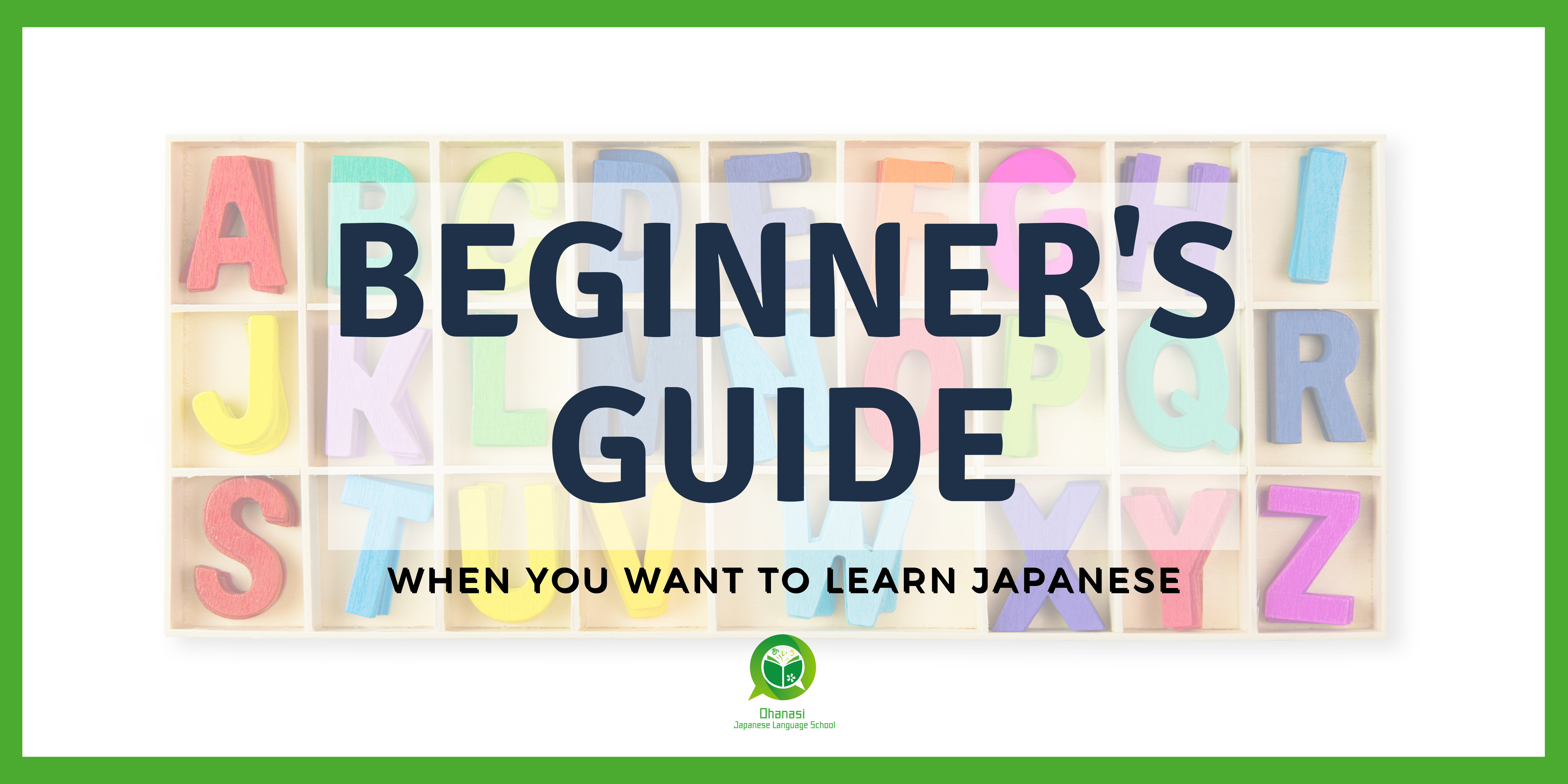
Learn Japanese
Japanese Culture
Ohanasi Kagawa
Ohanasi Japanese Language School
2023.07.04
Let’s have fun learning the Japanese alphabet! Beginner’s Guide When you want to learn Japanese…
When you want to learn Japanese, the first thing you may encounter is the alphabet. In this article, we will show you how to learn the Japanese alphabet effectively. Starting with the basics of hiragana and katakana, we will explain in detail, including memory techniques and practical application. Read to the end and you will be able to enjoy learning the Japanese alphabet! What is the Japanese alphabet? Let's learn the basics of hiragana and katakana! (How to learn alphabet in Japanese) How to learn alphabet in Japanese First of all, we will explain the basics of the Japanese alphabet. The Japanese alphabet includes hiragana and katakana. Both share the fact that they are derived from Kanji characters, but while hiragana is a broken down form of Kanji, katakana is a character made from a part of Kanji. Characteristically, one sound is fixed to one character. Hiragana and katakana exist as 50 sounds each, corresponding one to one. For example, "a'' in hiragana and "a" in katakana have the same sound. Some of the characters have a dotted or circled sound that becomes a muddled or semi-muddled sound. The difference between hiragana and katakana is that hiragana is the basis of the Japanese language, while katakana is often used for foreign words. In terms of the order of study, hiragana will come first. From here, hiragana and katakana will be explained respectively. Characteristics and basics of hiragana ( Japanese hiragana and katakana guide) Elementary school education Let us explain the characteristics and basics of hiragana. Hiragana is one of the characters used to write the Japanese language. Originally, men such as aristocrats and priests used katakana to write kanji in shorthand, but in the Heian period (794-1185), women and the general public began to write characters as well, and simple characters were needed. Therefore, hiragana developed from a broken form of kanji. Today, hiragana is mainly used in elementary school education and in books for children, and is also utilized along with kanji in daily life. As for the writing style, when writing with a brush, it is expressed in three movements: dots, horizontally, and vertically. However, with the spread of keyboard input, there is a trend where the correct stroke order, stop (tome), upward brushstroke (hane), and sweeping (harai) are becoming less important. Features and basics of katakana (Japanese hiragana and katakana guide) What are the characteristics and basics of katakana? On the other hand, what are the characteristics and basics of katakana? Katakana has its origins in an ancient Japanese writing system called Manyogana. In the Middle Ages, a mixed writing system of kanji and kana became the mainstream, and a system similar to the modern one was established in the Meiji era. Katakana is mainly used to write foreign words, technical terms in science and technology, and product names. It is also sometimes used to express words without kanji characters to enhance readability. All writing styles consist of straight lines and angular curves, and like hiragana, the order and direction of lines is important. However, the writing area is narrower than that of hiragana, and the characters are thinner toward the tips. How to learn the Japanese alphabet: effective practice methods (Japanese writing system basics) ow can we effectively practice the Japanese alphabet? How can we effectively practice the Japanese alphabet? Here are some effective ways to learn hiragana and katakana. - How to Practice Hiragana and Katakana - Mnemonic techniques for learning the Japanese alphabet effectively We will explain each of them in detail. How to practice hiragana and katakana There are some effective ways to practice hiragana and katakana First, here are some effective ways to practice hiragana and katakana. - Use of practice sheets By using hiragana and katakana practice sheets, you can learn how to write them correctly. The practice sheets can also be used for writing and reading practice, so you can broaden the scope of your practice. - Use of Online Resources Online resources can help you practice more efficiently. For example, by using websites and apps for learners of Japanese, you can practice using audio and example sentences. - The importance of repeated practice Hiragana and Katakana practice requires, above all, repetition. By writing and reading the same characters over and over again, you will be able to remember them accurately. It is also important to divide your practice into intervals so that you can increase the amount of practice. By practicing hiragana and katakana with the above perspectives in mind, you will learn how to write and read them accurately. How to memorize Japanese alphabets effectively (how to memorize Japanese alphabets) How to memorize Japanese alphabets Here are some memory techniques to help you memorize hiragana and katakana effectively and enjoyably! - Storytelling method By creating a story and having hiragana and katakana appear in the story, you can easily remember them. For example, by creating a story in which a "red rose" appears, you can memorize hiragana "a", "ka", and "i", and katakana "ba" and "la". - Associative Memory Method For hiragana and katakana, keywords that match the image of each word are set to make them easier to remember. For example, "a" is the color "aoi", "so" is the drink "soda", and so on. - The importance of periodic review Even if you think you have memorized a word, you may forget it over time. In particular, alphabets that are not used very often are rapidly forgotten. Therefore, it is important to review hiragana and katakana regularly to make them stick. For example, reviewing them for 10 minutes every day will help you remember them better in the long run. By being aware of the storytelling method, the association memory method, and the importance of regular review as described above, you can learn hiragana and katakana in a fun and effective way! Practice: Deepen your learning with activities using the Japanese alphabet! (top Japanese language websites) What are top Japanese language websites? From here, let's work on more practical learning! Here are some practical activities using Japanese alphabets. - Let's read Japanese sentences - Let's write your own Japanese sentences! We will explain how to enjoy and deepen your learning through reading and writing. Let's read a Japanese sentence Reading Japanese books... First, let's actually read some Japanese sentences. For reading short sentences, we recommend simple Japanese books, Japanese websites, and Japanese social networking posts. - For simple Japanese books, there are picture books and learning materials for children. They use basic grammar and vocabulary and are rich in pictures and illustrations. - You can read news and blogs on Japanese websites. Some sites are geared toward beginners, and you can improve your reading skills through short articles. - In Japanese social networking sites, you can read Japanese on Twitter and Instagram. You can learn real and colloquial expressions from users' posts and comments. Combined, these methods allow you to learn hiragana and katakana in a practical way. Build your foundation with simple Japanese books and deepen your learning through actual content on websites and social networking sites. By choosing topics that interest you, you will be more motivated to learn. Try writing your own Japanese sentences Try writing your own Japanese sentences! Finally, try writing your own Japanese sentences! You can learn how to use hiragana and katakana practically by writing your own Japanese sentences, such as self-introductions, daily conversations, hobbies and interests, and so on. In self-introductory sentences, you will express your name, hometown, hobbies, etc. in concrete terms. 「こんにちは、私はXXと申します。日本出身で、音楽や旅行が好きです」(Hello, my name is XX. I am from Japan and I like music and traveling.) In everyday conversation, imagine a conversation or scene with a friend and express what you want to say in a sentence. Write greetings, expressions of appreciation, questions and opinions. 「おはよう!今日は予定がある?」(Good morning! Do you have plans today?) or 「昨日の映画、面白かった!」(I enjoyed the movie last night!) We recommend using apps such as Twitter, Instagram, HelloTalk, etc. If you are writing about your hobbies and interests, write about what you like and are interested in. Try using specific expressions such as, 「最近は料理に興味があり、新しいレシピに挑戦しています」(Lately I've been interested in cooking and have been trying out new recipes. ) You may get a reaction from someone! Through this kind of practice, you may actually want to talk to Japanese speakers! Ohanasi Kagawa hosts free online language exchange events on weekends. English and Japanese learners are paired one-on-one and switch the language they speak every 15 minutes. If you are at all interested, please check out the details! In this article, we have explained in detail the basics of hiragana and katakana, the Japanese alphabet, as well as effective learning methods and practical activities. Use these methods to have fun learning the Japanese alphabet! 【For Japanese Learners】 Limited to 10 people Free Consultation & Japanese Lesson We are organizing a free Japanese language consultation & free Japanese lesson for Japanese learners. “Even though I’m studying Japanese, I can’t speak it.” “I don’t know how to study Japanese.” “I’m worried that I can’t see any progress.” Our Japanese Language Learning Counselors would be happy to listen to the concerns of such beginner- or intermediate-level Japanese language learners and advise them on how to learn Japanese and solutions that suit their needs. ※Due to the limited time of our Japanese Language Counselors, we limit the number of participants to 10. We at Ohanasi Kagawa are currently hosting an online Japanese-English language exchange event on weekends.However, we have noticed that there are many people who want to participate but are not confident enough in their Japanese to do so. We are holding this free Japanese language study consultation in the hope that we can help Japanese learners find hints to help them move forward.You can book through the calendar below, and we will send you a link for the free counseling by e-mail.If you’d like to take a Japanese lesson, you can take it for free during this time. Book a free counseling and trial lesson >>>

Learn Japanese
Japanese Culture
Ohanasi Kagawa
Ohanasi Japanese Language School
2023.07.01
【ADVICE to Japanese learners】Vol.1/ Do you lend your ears to Japanese friends?
Do you have some Japanese friends? If you do, I believe that today's topic is useful when you talk with them !! Hi!! I'm Satomi in Ohanasi Japanese Language School.Today, I'll teach you about what Japanese people feel is important in the conversation. Do you listen attentively to what your friends saying? I wonder if you listen attentively when you talk with your friends. You might think, “Of course, I always listen attentively.” Do you know that there are 2 kinds of words for “listen” in Japanese? They are “聞く” and “聴く”. I think you can communicate better with Japanese people if you understand the difference in their meanings. 【聞】and【聴】 First, there are 【門】and【耳】in the Kanji of 【聞】. On the other hand, there are 【耳】,【目】,and【心】in 【聴】, right? The difference between 【聞】and 【聴】is whether if there are 【目】【心】.(【目】means “eyes”.【心】means “heart”) In other words, 【聴く】means “listening with your eyes and heart”. It’s interesting, isn’t it? Do you know the word 【傾聴(けいちょう)】? For Japanese people it is very important. What does “listening with your eyes and heart” mean? People say, it’s important to listen attentively to others when you talk with others.(It means 【傾聴】). What’s 【傾聴】? The Kanji 【傾】in 【傾聴】is called 「かたむける」.「かたむける」means “to focus on certain things” too. That’s why, 【傾聴】means “listening to what the other person is saying mindfully”. The purpose of 【傾聴】is to understand the other person well while focusing on what he/she wants to say . You can make better relationships not only in special situations, but in daily situations, if you can do 【傾聴】. For this reason, many Japanese people are learning 【傾聴】. I'll teach you 5 points of 【傾聴】 that you can use easily from today in the next blog^^ このブログを日本語でよむ

Learn Japanese
Japanese Culture
Ohanasi Kagawa
2023.06.04
Learning Japanese Culture: Fascinating Topics and Effective Ways to Learn
When you hear the term "Japanese culture," what first comes to mind? Some of you may not yet know what kind of things are called Japanese culture. In this article, we will introduce some fascinating and interesting topics of Japanese culture and show you how to learn Japanese culture effectively. If you read to the end, you will be able to start learning about the Japanese culture you are interested in right away! Understanding the appeal of Japanese Culture First of all, what is Japanese culture? We will introduce some fascinating aspects of Japanese culture and its unique characteristics. Let's look at three types: traditional arts, food culture, and festivals and events. Traditional Performing Arts First, we will briefly explain the history and characteristics of the traditional performing arts that represent Japanese culture. In Japan, there are several traditional performing arts such as Kabuki, Noh drama, and tea ceremony. Kabuki is a Japanese intangible cultural heritage theater, which was born in Kyoto in 1603 and captivated people with its flamboyant costumes, makeup, and eccentric movements. It is composed of music, dance, and acting/directing, and is characterized by the fact that all roles, including female roles, are played by men. Nohgaku is a performing art registered as an Important Intangible Cultural Property of Japan and a UNESCO Intangible Cultural Heritage. Noh and Kyogen together are called Nohgaku. Noh is a masked drama consisting of song and dance. Kyogen is a drama centered on dialogues, similar to a comic or comic storytelling. Tea ceremony is a ritual in which the master of a house serves tea to his guests. When the knowledge of tea was imported from China during the Nara period (710-794), it became a ritual held at court. There are detailed rules on how to stand, walk, and sit, as well as how to bow, serve tea, drink, and greet guests. It is a great opportunity to learn the spirit of "Omotenashi," which became a hot topic during the Olympic bid presentation, and "Wabi Sabi," a uniquely Japanese aesthetic. Food Culture Japanese food, a traditional Japanese food culture, is registered as a UNESCO Intangible Cultural Heritage. Japan's unique four seasons are reflected in its cuisine, and there is a strong connection with annual events. It is healthy and nutritionally balanced because it makes use of the flavors of a wide variety of ingredients. You may have heard of soy sauce, miso, and other uniquely Japanese seasonings. Furthermore, sweets born in Japan are called "wagashi”. The appeal here, too, is that you can feel the changing of the four seasons. Made mainly from grains, beans, sugar, and other ingredients, they are served during tea ceremonies as refreshments. Traditional cuisine rooted in a region is called "local cuisine”. They are prepared using local specialties with unique cooking methods and flavors, and are so different that even among Japanese people they can be perceived as unique. Festivals and Events Japanese culture includes rituals known as matsuri. The cultural significance is to worship gods, Buddha, and ancestors for thanksgiving, prayer, and consolation. Japan is a polytheistic or non-believing country, and you may be surprised at the difference in mindset from monotheistic religions such as Christianity and Islam. There are countless festivals throughout Japan, but the three biggest in Japan are the Kanda Festival in Tokyo, the Gion Festival in Kyoto, and the Tenjin Festival in Osaka. A good way to enjoy these festivals is to wear yukata (light cotton kimono), shop at the "yatai" stalls that are set up in conjunction with the festivals, and watch the dancing and portable shrines (vehicles for the gods) of each festival. In addition, fireworks are often displayed at night. Resources for Learning Japanese Culture What can I do to learn about these aspects of Japanese culture? Here are some useful resources to help you delve deeper into Japanese culture. Movies, Dramas, and Anime First, how about movies, dramas, and anime that you can enjoy while learning about Japanese culture? Especially if they are non-fiction based on actual experiences, you can get a more realistic sense of life in Japan. The lifestyle in Japan has changed dramatically since the 2021 era, the Heisei era, and the Showa era, so it would be interesting to watch while being aware of the historical background. In addition, some anime that are popular overseas have strong creative elements, but festivals and other annual events are often carefully depicted. We encourage you to expand your image of Japanese culture while having fun. Online Courses and Webinars Next, we would like to introduce you to online courses and webinars where you can learn about Japanese culture. Even if you want to learn about Japanese culture in a nutshell, it is a hurdle for a complete beginner to start learning on your own. However, online courses and webinars are a great way to learn about Japanese culture in a systematic way. The advantage is that the time and place are flexible, so you can learn without problems even if you live abroad. We recommend this program for those who would like to learn properly with the help of a facilitator, although watching movies, dramas, and animations are also good. Ways to Experience Japanese Culture Finally, here are some ways to experience Japanese culture. As you gain more input about Japanese culture, many of you may want to actually experience and interact with Japanese culture. Let's take a look at three different ways to do this: using a language exchange or homestay, taking advantage of cultural experience programs and events, and actually visiting Japan. Language Exchange and Homestay The first way to experience Japanese culture is through a language exchange or homestay. Through these, you can learn about Japanese culture directly from Japanese people, which is an advantage. Language exchange is especially recommended for those who have become interested in the Japanese language as they learn about Japanese culture. If you learn about Japanese culture through the Japanese language, you will probably gain a deeper understanding of the unique Japanese way of thinking. Also, if you actually have the opportunity to travel to Japan, consider a homestay. By living with a Japanese family, you may discover detailed cultural customs that cannot be depicted in movies, dramas, or seminars. Cultural Experience Programs and Events Next, we would like to introduce programs and events that allow you to experience Japanese culture. For example, events could include cooking Japanese food together, trying on kimonos together, or watching kabuki and having it explained to you. Information on these can be gathered online, so please search for Japanese cultural experience programs and choose the ones you are interested in based on reviews and reputation. Points to note are to carefully check the target age range, online/offline, participation fees, and who is hosting the event. Many programs are organized by Japanese language schools as well as local communities, so check them as well. Visiting Japan In this section, we would like to recommend some of the best places to visit and activities to do when visiting Japan to experience Japanese culture. One of the best ways to enjoy the local cultural experience is to choose dates when you can see traditional performing arts and festivals. Festivals are not always held, so if you want to attend a festival, check the Internet for the dates of the festivals you are interested in and take care to come to Japan accordingly. Also, some traditional performing arts require tickets. To see kabuki, for example, in a large theater, you will need tickets priced differently for each seat, so check your budget and your view of the stage carefully before purchasing. If you want to enjoy Japanese cuisine, you should do your research on the area you are visiting. The world-famous tourist destinations include Tokyo, Kyoto, and Osaka, but there are many other areas to visit and enjoy local cuisine. Please don't narrow your view and check out the attractions of various regions before choosing a place to visit. Summary Are you excited to learn about Japanese culture? It is easy to think that you have to visit Japan in person to experience Japanese culture, but we recommend that you start by enjoying the Japanese people online. Ohanasi Kagawa offers free online language exchange events on weekends. Japanese and English learners are paired one-on-one and swap the language they speak every 15 minutes, creating an environment where they can teach and learn from each other, which is one of its strengths. It is a valuable opportunity to meet Japanese people, and some events are dedicated to learning about Japanese culture, so please take a closer look first. Ohanasi Kagawa Website >>> That said, you might still not be confident in your Japanese speaking ability. You’re not sure how to study Japanese. For people like that, we are currently offering free Japanese language consultation and free lessons for a limited number of 10 people each month.You don’t know how to study Japanese. If you are interested in taking Japanese lessons to solve what you don’t understand, please feel free to join us.If you are interested, please click the URL or image below. Click here to see more details >>>

Learn Japanese
Japanese Culture
Ohanasi Kagawa
2023.06.01
What languages are spoken in Japan? If you want to study Japanese! Types, official language, and second language.
If you are interested in Japan, the first thing you will probably wonder about is the language spoken in Japan. When you go to Japan, you would like to know about the official language and second language used in Japan. In this article, I will talk about the types of languages spoken in Japan. In addition, I will introduce whether foreign languages are used in Japan. And in the end, I will tell you how to learn Japanese. By reading this article, you will know exactly how to learn the official language of Japan and the Japanese language! What is the official language in Japan? Japanese is the language of Japan. SUSHI and RAMEN would be voted as the most famous Japanese words in the world. Japanese is, of course, the language spoken in Japan. However, it is not actually an official language of Japan. You might be surprised but Japan does not have an official language. There is only one country in the world where Japanese is an official language. That is Palau. Did you know that Palau was a mandate territory of Japan at the time of World War II? In short, Palau was under the control of Japan. Japanese was used due to the influence of school education in Japanese, which led to the establishment of the Japanese language as the official language. Today, Japanese is still designated as the official language of the Angaur Province of the Republic of Palau, but there are few people who speak Japanese in Palau. This is because Palau has more than one official language. In Palau, Palauan and English are the official languages, in addition to Japanese. So, Palauan is mainly spoken. By the way, some words based on Japanese are also found in this Palauan language. Please check out some interesting Palauan words originating from Japanese, such as "Atama-guruguru," which means confusion. In Palau, several languages are spoken, such as Palauan, English, and Japanese, but Japanese is the dominant language in Japan. Languages from various countries such as English, Portuguese, Chinese, and French have been incorporated into Japanese as foreign languages, but Japanese has been spoken consistently. Dialects do exist, but they are part of the Japanese language. There was no need to designate Japanese as the official language of Japan. For this reason, there is no official language in Japan legally until today. In the future, when the number of foreigners living in Japan increases and a variety of languages got spoken in Japan, Japan may have an official language. What languages are actually spoken in Japan? Now, let's look more closely at the languages spoken in Japan. The most widely spoken language in Japan is Japanese. The Japanese language is divided into several dialects, and the language based on the Tokyo dialect is considered the "standard Japanese." Japanese dialects are broadly divided into "Mainland" and "Ryukyu." Furthermore, it is also divided into "Eastern Japan," "Western Japan," and "Kyushu." There are more Japanese with has a different "accent," which has "difference intonation, pronunciation, and accent" depending on the region. In addition to Japanese, there are the Ainu language of Hokkaido and the Ryukyu language of Okinawa Prefecture. Let me introduce each of them. Kanto area in East Japan The Kanto area is in eastern Japan. Starting with Tokyo, the capital of Japan, the six prefectures of Kanagawa, Chiba, Saitama, Gunma, Tochigi, and Ibaraki are often referred to as Kanto. In Kanto, "standard Japanese" is basically used. Standard Japanese is a grammar and speech style that is widely accepted within a group of people. In other words, the standard language is the language that can be understood anywhere in Japan. In Japan, standard Japanese has been formed based on the Tokyo dialect. Although there are no clear rules, the Japanese textbooks used in school education have a strong influence on the written language. In the spoken language, NHK announcers' accents and intonations serve as role models. Both are things that people born and raised in Japan have many opportunities to meet. So, they have grown up as language that is understood throughout Japan. So far, we have told you that standard Japanese is generally spoken in the Kanto area. However, there are of some dialects in the Kanto area as well. There are basically unique dialects for each prefectural unit, such as the "Tochigi dialect" spoken in Tochigi and the "Ibaraki dialect" spoken in Ibaraki. I will introduce them next time. If you are interested, please look it up by "prefecture name + dialect". Large cities outside of Kanto area Next, let's look at the areas outside the Kanto area that are called "large cities". The Statistics Bureau of the Ministry of Internal Affairs and Communications designates the following areas other than the Kanto area as large cities. ・Sapporo, Hokkaido ・Sendai City, Miyagi Prefecture ・Niigata City, Niigata Prefecture ・Shizuoka City, Shizuoka Prefecture ・Hamamatsu City, Shizuoka Prefecture ・Nagoya City, Aichi Prefecture ・Kyoto City, Kyoto Prefecture ・Osaka City, Osaka Prefecture ・Sakai City, Osaka Prefecture ・Kobe City, Hyogo Prefecture ・Okayama City, Okayama Prefecture ・Hiroshima City, Hiroshima Prefecture ・Kitakyushu City, Fukuoka Prefecture ・Fukuoka City, Fukuoka Prefecture You can see that large cities can be found all over Japan. From Hokkaido in the north area to Fukuoka, Kyushu, in the south area. In these areas, standard Japanese is basically spoken. However, it is common to find dialects and accents in the language spoken by the people who live there. Outside large cities Outside of large cities, dialects and accents are more commonly used. Vocabulary, grammar, accent, and intonation are very different from standard Japanese. Even Japanese people from different backgrounds often do not understand each other's dialects. In addition, languages other than Japanese are spoken in Hokkaido and Okinawa. Hokkaido, the northern island of Japan, is home to people who speak the Ainu language. They are the indigenous Ainu people of Hokkaido. Today, the Ainu language is on the verge of extinction due to increased intermixing with Japanese and the increasing popularity of the Japanese language among the Ainu. The Japanese language is also known to retain words borrowed from the Ainu language, such as "reindeer" and "sea otter". Okinawa Prefecture, the southernmost prefecture in Japan, has a Ryukyuan language. An independent small island, Okinawa Prefecture was originally a separate country called the Kingdom of Ryukyu. The Ryukyuan language was spoken in that country. Today, it is sometimes treated as part of the Japanese language, such as the Okinawan dialect, but linguistically, it is a completely different language from Japanese. This is also a language in danger of extinction, with the number of speakers decreasing every year. Thus, although non-Japanese languages such as Ainu and Ryukyuan existed, they are now almost entirely Japanese. Can foreign languages be understood in Japan? Japan has no official language, but the dominance of Japanese is overwhelming. The indigenous languages Ainu and Ryukyu are also in danger of extinction, and it is safe to say that no second language exists. English is taught in mandatory education, but it is not widely used. If you want to speak English, younger people may be more likely to do so. This is because English education has become more widespread among younger people in recent years, with English education becoming a requirement in elementary schools. If you want to use a language other than English, it is recommended to use a translation application. If you want to learn Japanese To summarize what I have explained, Japanese is the dominant language in Japan. Although the Japanese language is characterized by a rich variety of dialects, the standard Japanese is basically spoken in the Kanto area, especially in Tokyo. Furthermore, even in large cities outside the Kanto area, you will be able to speak in standard Japanese. Outside of large cities, standard Japanese is still spoken, but locals may have a strong dialect or accent. English is also listed as a second language in Japan, but it is not widely spoken throughout the country. So, if you want to learn Japanese in Japan, the Kanto area is a good place to start. Outside of the Kanto area, choose one of the larger cities to make it easier to learn the standard language that is understood throughout Japan. As a first step, we also recommend online Japanese language classes and online events. In the case of online transactions, the standard language is often adopted regardless of the region. It may be a good idea to learn online first, and then learn Japanese in earnest in Japan. Ohanasi Kagawa holds online language exchange events on weekends. Japanese language learners and English language learners are paired together. You then switch between English and Japanese every 15 minutes. This way, both of you can learn a language. Online, you can communicate with Japanese people without having to go to Japan. The rules are designed to ensure that you can participate safely. So, even if you are new to online events, please check them out. This is the perfect event for those who want to spend a little time in Japanese while maintaining their current lifestyle. Ohanasi Kagawa Website >>> That said, you might still not be confident in your Japanese speaking ability. You're not sure how to study Japanese. For people like that, we are currently offering free Japanese language consultation and free lessons for a limited number of 10 people each month.You don't know how to study Japanese. If you are interested in taking Japanese lessons to solve what you don't understand, please feel free to join us.If you are interested, please click the URL or image below. Click here to see more details >>>

